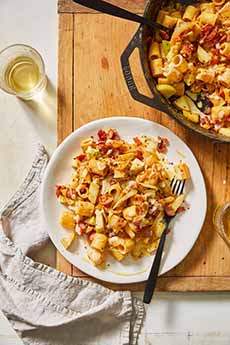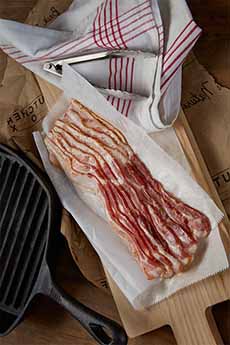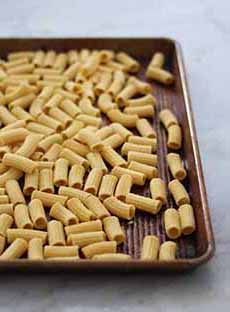RECIPE: Fall Pasta Carbonara With Bacon & Apples
|
|
October is National Pasta Month. We have a fall-focused recipe using mezzi* rigatoni, or half-size rigatoni (photo #2), from Delallo. The recipe for Pasta Carbonara With Bacon & Apples is below, after a discussion of rigatoni—a cut that many non-cooks can confuse with penne. Rigatoni (righ-gah-TOE-knee) are tube-shaped ridged pasta (see the ridges close up in photo #3). Ridged pasta, or pasta rigate (rih-GAH-tay) in Italian, is a style that developed during the Industrial Revolution. New mechanization enabled more sophisticated machine shapes, made with extruders. While some pre-industrial artisans labored to make ridged pasta, the effort required was not likely cost-effective. But voilà: Bring on the machinery and bronze dies to extrude pasta, and you’ve got all the ridged pastas (and other shapes) one can desire. Ridged pasta was an immediate hit. It enabled chunky meat and vegetable sauces to better cling to the surface, lodging in the grooves. That was a bonus for the tubular pastas, which allow the sauce to be inside and outside. According to Barilla and The Pasta Project, rigatoni were created in Rome in 1930. While this may seem long ago to some, it is relatively recent given that pasta has been made in Italy since the 8th century (the history of pasta).” Rigatoni became a mainstay in Lazio (the province of which Rome is the capital). Of note is the classic Roman dish La Pagliata (also called Pajata), made with the intestines of an unweaned calf (one only fed on its mother’s milk. Here’s more about it. Rigatoni traveled to southern Italy, where they became a favorite combined with local ingredients. Rigatoni are are larger than penne and ziti. They are made in varying lengths and diameters, based on the manufacturer. Typical rigatoni are approximately 1-1/2 inches in length and 1/2 inch in diameter. Mezzi Rigatoni are approximately 5/8 inch in length with a diameter of 1/2 inch. The differences between rigatoni and penne: Other rigate pasta include: Ingredients 1. BEAT the eggs and cheese together in a large serving bowl. Add salt and pepper. Set aside. 2. HEAT the olive oil and garlic in large saucepan. Once the garlic begins to turn golden, remove it from the oil and discard. Add the bacon to the pan and sauté until it becomes golden brown, about 6 minutes. Remove with a slotted spoon and set aside. 3. ADD the onion to the pan and cook until it begins to soften, about 6 to 8 minutes. Add the apple to the pan. Cool together with the onions for 3 to 4 minutes. 4. ADD the bacon back to the pan and season with chili pepper to taste. Meanwhile… 5. BRING 5 quarts of salted water to a boil. Cook the pasta according to package instruction. Drain, reserving 2 cups of the pasta water to finish the sauce. 6. COMBINE the hot pasta with the apple mixture and oil in the serving bowl with the eggs and cheese. Toss to coat and to gently cook the eggs with the heat of the pasta. Once combined… 7. ADD about 1/4 cup of the reserved hot pasta water and toss. If the pasta appears too dry, add another splash of pasta water. Serve immediately sprinkled with additional cheese. |
|
|
________________ *Mezzi rigatoni, often misspelled in the U.S. as mezze rigatoni. Both word variations mean “half,” but rigatoni is a masculine noun and takes the masculine plural adjective, mezzi. Mezze would modify a feminine noun. †Manicotti is the Italian-American version of cannelloni. Manicotti tubes are ridged, larger and slightly thicker; cannelloni tubes are smooth, a bit smaller and slightly thinner. |
||




![[ ] .](https://blog.thenibble.com/wp-content/uploads/granny-smith-lisasolonynko-morguefile-230low.jpg)



